When Copper Cabling Is Used To Carry T-1 Traffic, What Kind Of Connector Is Used?
Ethernet Cables Explained
In 1973, Xerox PARC researcher Bob Metcalfe invented a high-speed networking system called Ethernet to allow figurer workstations, servers and printers to share data and resource. Today, Ethernet connects hundreds of millions of devices in homes and businesses. In this article, nosotros explain the Ethernet cablevision types that form the footing of many wired networks.

Buying Ethernet Cablevision for your Network
If you are buying Ethernet cable for the kickoff time, focus on these four features and you'll make a skilful determination. Other factors are worth considering in certain circumstances so if in doubtfulness, read on.
- Speed (Data Rate): the speed of a cable refers to the amount of information it can transmit per second. 100 Mbps means the cable can transmit 100 1000000 bits of information a second. In a commercial network, speed is usually dictated by the equipment you are connecting (for instance, a network switch with Gigabit Ethernet ports). In the home, cull a cable that can support the speed of your Internet connection, plus some room for speed upgrades in the future. A cable'southward Category designation (e.grand. Cat5e, Cat6, etc.) is an easy way to place the speed of a cable. See Table 1: Category Cable Summary for more information.
- Shielding: some Ethernet cables are shielded to protect the cable'due south condutors from electromagnetic interference (EMI) caused past power lines, large mechanism and flourescent lighting. Shielding besides prevents parallel conductors inside the cable jacket from interacting with one another. See Ethernet Cable Shielding for more information.
- Cable Length: The maximum length of an Ethernet cable is about 295 feet (90 meters). Good quality cables with shielding and thicker conductors tin can attain farther but some trial and error will be required. Go on in mind that cable runs are rarely direct so plan on extra cable for some twists and turns. See Ethernet Cable Length for more information.
- Installation Location: cable jackets are rated for fire safety. If you program on running cablevision through walls or between floors, choose ascension-rated (CMR) or plenum-rated (CMP) cable. See Jacket Ratings for more data.
Why Purchase from Tripp Lite?
We know y'all have many brands to choose from. On the surface, they may all seem alike. It's what y'all don't see that makes the difference. With Tripp Low-cal, yous become solid engineering, proven reliability and exceptional customer service. All our products undergo rigorous quality command before they are offered for auction, and independent testing agencies verify our products meet or exceed the latest safe and performance standards. Our delivery to quality allows united states of america to dorsum our products with industry-leading warranties and responsive customer service. It's the Tripp Calorie-free divergence.
Ethernet Cable Categories
The "True cat" in Cat5e, Cat6, etc. is short for "Category." Network cables are divided into categories based mainly on bandwidth (measured in MHz), maximum data rate (measured in megabits per second) and shielding.
Bandwidth vs. Data Rate
Bandwidth or frequency is a property of a cable and measures the charge per unit at which a signal volition cycle each second. ane MHz is equal to 1 million cycles per second. Cat5 can handle up to 100 million signals a second (or 100 MHz). The cable category with the highest bandwidth is currently Cat8 with 2 billion (2 GHz) signals per second, 20 times as many every bit Cat5.
Information Rate and Bandwidth are related terms but they are not the same. College frequencies behave more 1s and 0s, allowing more bits of data to be transmitted per second. Cat5 cables have a one-to-one relationship between bandwidth and information rate: 100 MHz cablevision can transmit 100 Mb per second. College Category cables such equally Cat8 encode the data so more bits can be transmitted in the same amount of time.
Frequency (and therefore information charge per unit) can be increased past increasing the gauge of the usher wires, adding more twists to the conductors, or calculation shielding to each pair of conductors.
| Category | Max. Data Charge per unit | Bandwidth | Max. Altitude | Usage |
|---|---|---|---|---|
| Category i | one Mbps | 0.4 MHz | Phone and modem lines | |
| Category 2 | 4 Mbps | 4 MHz | LocalTalk & Telephone | |
| Category iii | 10 Mbps | 16 MHz | 100 g (328 ft.) | 10BaseT Ethernet |
| Category 4 | xvi Mbps | twenty MHz | 100 1000 (328 ft.) | Token Band |
| Category v | 100 Mbps | 100 MHz | 100 chiliad (328 ft.) | 100BaseT Ethernet |
| Category 5e | i Gbps | 100 MHz | 100 m (328 ft.) | 100BaseT Ethernet, residential homes |
| Category six | i Gbps | 250 MHz | 100 m (328 ft.) 10Gb at 37 k (121 ft.) | Gigabit Ethernet, commercial buildings |
| Category 6a | 10 Gbps | 500 MHz | 100 m (328 ft.) | Gigabit Ethernet in data centers and commercial buildings |
| Category 7 | 10 Gbps | 600 MHz | 100 m (328 ft.) | x Gbps Core Infrastructure |
| Category 7a | 10 Gbps | 1000 MHz | 100 m (328 ft.) 40Gb at 50 m (164 ft.) | 10 Gbps Core Infrastructure |
| Category 8 | 25 Gbps (Cat8.1) 40 Gbps (Cat8.2) | 2000 MHz | thirty m (98 ft.) | 25 Gbps/xl Gbps Cadre Infrastructure |
What blazon of Ethernet cable should I purchase for my habitation network?
Even with a speedy WiFi6 router, your connection to the Internet is normally the bandwidth clogging. Currently, the fastest Internet plans available from the major carriers offer download speeds of 1 gigabit per 2nd (1,000 Mbps). If you already take the fastest Internet access available from your provider, utilize Cat6a cable. This will give you some headroom for future speed increases. For Internet download speeds up to a gigabit, Cat5e is a good choice. You'll save a little coin over Cat6a and the thinner cable will exist easier to install.
Ethernet Cable Length
The further a signal has to travel along a cable, the more information technology will degrade (a procedure known as attenuation) until it reaches the point where it tin no longer be detected, or is likewise distorted to exist interpreted by the receiving device. Attenuation can also be acquired by noise due to electrical currents and radio frequencies. Cables with shielding to minimize noise volition work reliably over greater distances.

The maximum length of a Cat5e or Cat6 Ethernet cable is about 295 ft. (ninety m), plus up to xvi ft. (v m) of patch cable on either finish, for a full of 328 anxiety or 100 meters. Across this, the signal begins to degrade, reducing the speed and reliability of the connection. Good quality cable can support runs in excess of 100 meters but data manual speed may exist reduced. Higher data rates can also be achieved over shorter distances.
Ethernet Cable Shielding
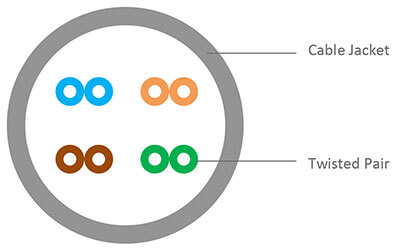
Unshielded Twisted Pair (UTP)
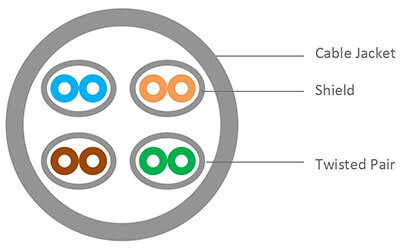
Shielded Twisted Pair (STP)
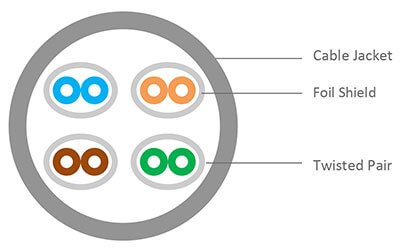
Foiled Twisted Pair (FTP)

Outer Foil Shield/Unshielded Twisted Pair (F/UTP)
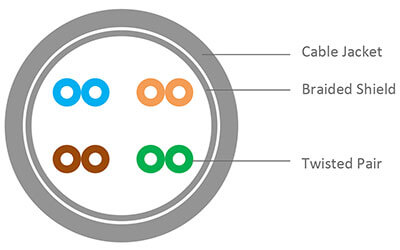
Outer Braided Shield/Unshielded Twisted Pair (S/UTP)
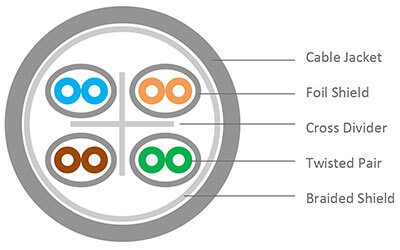
Outer Braided Shield/Foiled Twisted Pair (S/FTP)
Ethernet Patch Cords and Connector Styles
Termination
Ethernet cables made from four twisted pairs are terminated using an 8-pin RJ45 connector. Older telephone cable based on two twisted pairs typically use RJ11 connectors.
The terms 8p8c (Eight Position, Viii Contact) and RJ45 are often used interchangeably merely 8p8c really refers to a category of connectors of which RJ45 is one. The modernistic RJ45 Ethernet connector is the most common case of an 8p8c connector.
GG45 (GigaGate 45) or ARJ45 (Augmented RJ45) is a connector originally developed by French cable company Nexans for use with Cat7 cable. GG45 connectors take 12 pins in total, viii providing backwards compatibility with Cat6, and an boosted four pins providing support for frequencies of upwardly to 600MHz.
M12 coded connectors are found on Ethernet cords designed for industrial applications. These cables are frequently exposed to vibration, extreme temperatures and moisture. The threaded connectors are designed to provide a waterproof and secure connection.
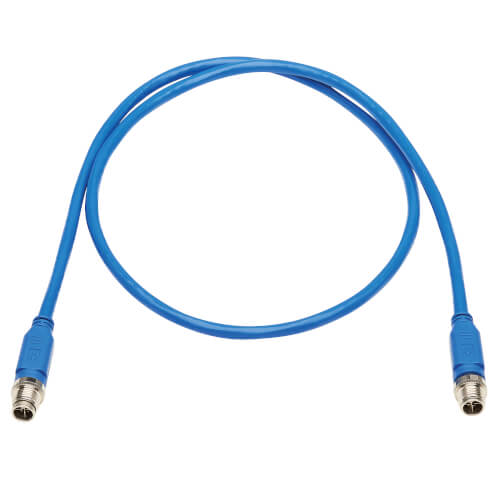
Why is an Ethernet cable connector called RJ45?
"RJ" stands for Registered Jack and refers to a standardized physical network interface. The "45" simply refers to the number of the interface in the standard specification.
Connector Styles
Molded connectors are permanently attached to a cable using a manufacturing process called over-molding. The connector and cablevision are covered with a thermoplastic or silicon material to form i solid piece chosen a boot, making the cablevision more durable and able to withstanding a high number of insertion cycles.
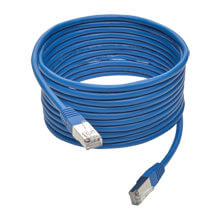
Snagless connectors have a modified boot that protects the connector's lock from being accidentally snapped off. Snagless cables are typically used in situations where the cable is frequently connected and asunder, such as a laptop-to-wall network connexion.
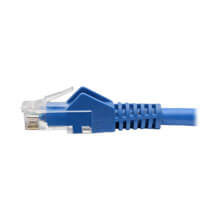
Cable Styles
Slim and Ultra-Slim Cables
Slim and Ultra-Slim cables take a bore that's typically 30-l% less than that of a standard Cat6 cable. Manufactured from modest gauge copper wire, the 4-pair stranded cable increases airflow in crowded equipment racks, which helps keep components cool and functioning properly. The slim design also makes the cable lighter and easier to install in loftier-density racks, cable trays and ductwork.
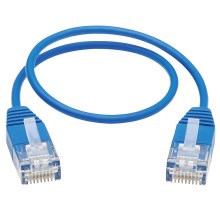
Flat Cables
Although non a common option, flat cables have some unique characteristics that make them beneficial in certain applications. Flat cables have practiced heat dissipation and more evenly distribute concrete loads on the cablevision. They likewise bend only through the broad faces whereas a conventional round cablevision bends in all directions.
A flat cable is a practiced choice if you need to carry an Ethernet patch cable effectually in your laptop bag. It is strong, light and will not tangle hands. Its apartment shape makes it ideal for cable runs under carpet and behind baseboard.

Solid Core Cables
Network cables are available in stranded and solid wire formats. As the proper noun suggests, a solid core cable uses ane solid copper wire for each usher, then a iv-pair cable volition have a full of viii solid copper wires. Solid conductor cablevision is like shooting fish in a barrel to punch down, making it platonic for structured wiring applications.
In situations where a cable is repeatedly flexed or connected and disconnected, choose a stranded cable. For horizontal cablevision runs not subject to repeated motion, or for Power-over-Ethernet (PoE) and outdoor applications, utilise solid core cablevision.
Armored Cable
The outer jacket of an armored cable is fabricated from thermoplastic polyurethane (TPU), a type of polyurethane known for its strength, flexibility (even in depression temperatures) and cutting/chafe resistance. Armored cable is recommended for outdoor applications and any location where the cable could potentially be crushed or cutting.
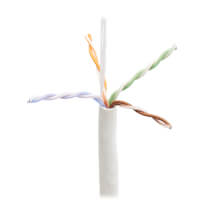
What is a Crossover Cable?
There are two wiring standards used by RJ45 connectors, referred to as T568A and T568B. The difference is the pin assignment for the dark-green and orange pairs. T568A pinouts are the near commonly used just either will work then long equally both ends of the cablevision are similarly wired. The U.Southward. Authorities requires the use of the T568A standard for networks installed nether a federal contract.

| PIN | Indicate | T568A | T568B |
|---|---|---|---|
| 1 | TX+ | White/Green | White/Orange |
| two | TX- | Green | Orange |
| 3 | RX+ | White/Orangish | White/Green |
| 4 | TRD2+ | Blue | Bluish |
| 5 | TRD2- | White/Blueish | White/Bluish |
| six | RX- | Orangish | Green |
| vii | TRS3+ | White/Brown | White/Brown |
| eight | TRS3- | Brownish | Brownish |
Wiring eight-Position RJ45 Modular Plugs: T568A and T568B Wiring Patterns
Cables with T568A wiring on i end and T568B on the other are known as "crossover" cables. You can identify a crossover cable past comparison the society of wires on each end. If the wires are the same on each stop (regardless of which pin configuration is used), it is a "directly-through" cable. If they are different, it is a crossover cable.
Present, most Ethernet switches and routers accept a feature called auto-MDIX, which can detect which type of port or cablevision (crossover or straight-through) is connected and swap the transmit and receive pins accordingly, removing the need for crossover wiring.
Gauge
One of the factors limiting the length and data rate of Ethernet cable is the size of its conductors. Electrical current encounters greater resistance when transmitted over thinner wire. The larger the conductor, the easier it is for the electrons to laissez passer through it resulting in lower resistance, lower bespeak loss and greater transmission altitude.
The diameter or guess of a cable's conductor is referred to using American Wire Estimate (AWG) standard sizes. For case, a 24 AWG solid usher is 0.0201 inches in bore. A 28 AWG conductor is 0.0126 inches in diameter, virtually half the size. That'south correct, the smaller the AWG gauge, the bigger the conductor diameter.
| Cable Type | Typical Gauge | Diameter (inches) | Diameter (mm) |
|---|---|---|---|
| Cat8 | 22 AWG | 0.0253 | 0.6438 |
| Cat6/Cat6a | 23 AWG | 0.0226 | 0.5733 |
| Cat5e | 24 AWG | 0.0201 | 0.5106 |
| Slim Cat6 | 28 AWG | 0.0126 | 0.3211 |
| Ultra Slim Cat6 | 32 AWG | 0.0080 | 0.2019 |
Usher gauge affects a cable'due south performance simply is typically not the most important factor. Shielding and twist charge per unit accept more impact on signal strength and quality.
Twist Rates
E'er wondered why an Ethernet cable uses twisted pairs of conductor wires? Early telephone lines were susceptible to interference from electrical wires that often shared the aforementioned utility poles. Engineers discovered that by swapping the position of the telephone wires every few poles (i.e. the left line became the correct and the right became the left), they could reduce baloney. This technique of wire transposition was the first use of twisting, albeit with a very loose twist charge per unit of about six turns per mile.
In 1881, Scotsman and AT&T co-founder Alexander Graham Bell used the same technique to create the starting time twisted pair. Past the turn of the 20th century, twisted pair cablevision was widely used for transmission of signals on voice telephone lines.
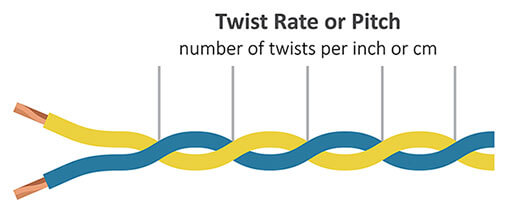
Today, twisting usher pairs is a common way to minimize signal interference and crosstalk, and increase cable performance. The twist charge per unit or "pitch" is commonly measured equally the number of twists per inch or centimeter.
Twist Rate is not specified in the IEEE or TIA category cablevision standards and is left to the manufacturer to make up one's mind. Cat5e typically has a twist rate of 4-5 twists per inch whereas Cat6 cables have a twist rate of 5 or more twists per inch. To farther reduce crosstalk, not all conductor pairs in a cablevision will have the same twist rate.
Jacket Ratings
Jackets protect the cable's conductors from physical damage, wet and ultraviolet calorie-free. When installing cable in walls, ceilings and under floors, it is important to use cables that see the local code requirements (unremarkably based on the NFPA's National Electric Code). The three bones ratings for both cable types are general purpose, riser and plenum-rated.
| Jacket Rating | Description | Applications | Acceptable Substitute |
|---|---|---|---|
| CM/CMG | Communications, Full general Purpose | Patch cables. In-room cable runs. Not for use in risers and plenum. | CMR, CMP |
| Riser (CMR) | Communications, Riser A riser is a vertical space, typically inside walls and between floors | In-wall installation May be required due to insurance or contractual clauses | CMP |
| Plenum (CMP) | Communications, Plenum Plenum is space above and below floors typically occupied past heating and air conditioning ductwork | Air ducts and plenums to a higher place and beneath floors. May be required due to insurance or contractual clauses. | |
| Outdoor (CMX) | Outdoor LDPE (low-density polyethylene) | Exterior installation. Buried or exposed to moisture or UV low-cal. Cable runs up to 50-ft. |
Special Applications
Power over Ethernet (PoE)
PoE allows both power and data to be delivered over a single, solid core category cablevision. This makes it ideal for networking IP devices like security cameras, access control readers, wireless access points (WAPs), sensors and lighting that crave DC power and a data network connection. PoE gives yous the flexibility to install devices where yous need them without having to worry virtually access to AC ability.
Further Reading
A Brief Overview of Power over Ethernet (PoE)
Limited Power (LP) Applications
UL has developed a Limited Power Certification for Ability-over-Ethernet (PoE) applications. The LP designation, commencement introduced in 2015, indicates that a cable has been tested under "reasonable worst case installation scenarios" and is capable of carrying the stated current without exceeding the temperature rating of the cable. The LP designation is peculiarly important in PoE++ applications where ability exceeds lx watts.
Outdoor Cable
Outside-grade CMX Ethernet cable is waterproof and resistant to drying and bang-up subsequently long-term exposure to the sun. Information technology can besides be buried in the basis without a conduit. Also consider cablevision and hooded connectors with an IP68 rating.
Plenum Spaces and Risers
Plenum is the space in a higher place or beneath a room that provides a manner for air to return to a building'southward HVAC arrangement. A riser is a vertical shaft between floors for electrical wiring, water pipes, and voice or information cabling. In the event of a fire, it's critical that cabling in these areas does not promote the spread of smoke and toxic fumes.
When selecting cablevision to run through plenum or risers, look for products with a jacket rating of CMP (plenum) or CMR (riser). These cables have a college caste of burn resistance and emit fewer toxic fumes compared to general purpose CM or CMG rated cables. In the U.s., the NFPA's National Electrical Code (NEC) guidelines requires CMP or CMR cabling for plenum or risers and compliance may be a contractual or legal requirement. Because CMP cables take a higher burn resistance, you can utilise CMP in risers but you cannot use CMR cable in plenum spaces.
Anti-Bacterial Cables
The jacket on these cables is constructed using an antibacterial fabric that is 99.9% effective in inhibiting Escherichia coli (East. coli) and Staphylococcus aureus (staph). This added protection makes these cables an ideal solution for high-touch applications and in environments where bacterial infection is of particular business organization, such every bit medical facilities, schools, process manufacturing and restaurants/kitchens.
Choosing Ethernet Cables
What is the difference between Cat5 and Cat6?
Cat6 and Cat6a cables are more than expensive than Cat5e so information technology'southward important to know what you're getting for your money. For cable runs up to 50-ft, Cat6 is capable of 10 Gbps vs. one Gbps for Cat5e. For longer runs, Cat5e and Cat6 should requite like performance.
Should I upgrade from Cat5e to Cat6?
Upgrading to Cat6 makes sense if the equipment on either finish is capable of ten Gbps. For example, cadre network connections betwixt switches, routers or bridges would benefit from the higher bandwidth.
Are Cat8 cables worth the extra money?
Cat8 is designed for switch-to-switch communications in 25G and 40G networks. Residential and commercial projects outside the information center would be improve using Cat6a cable. Not just is information technology less expensive, it'south as well easier and faster to install.
Can y'all mix Cat5 and Cat6 cable in a network?
In that location'southward no trouble in mixing Cat5e and Cat6 cable in the same network so long as yous don't create a bottleneck. Use Cat6 in the parts of your network where fast data transfer is important, such every bit between a switch and a router.
Are all Cat6 cables the same?
All expert quality cables that take been tested and certified by the manufacturer for a certain bandwidth and information rate are essentially the aforementioned. Shielded Cat6 and Cat6a cable volition give you lot better operation than unshielded, particularly when cables must be run in shut proximity to power lines or large electric equipment.
Do cheap cables work just besides?
In a word, no. Category cables are made of solid or stranded copper but some companies sell cheap versions made with Copper Clad Aluminum (CCA), an aluminum conductor that is coated with copper. These cables are cheaper to manufacture but result in a weaker cable that does not perform besides.
Products Mentioned in this Commodity

Cat5e
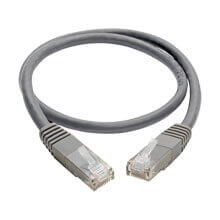
Cat6

Cat6a
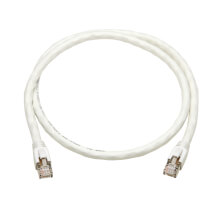
Cat8
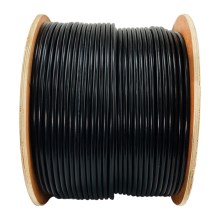
Bulk Cable
Why Buy from Tripp Low-cal?
Nosotros know y'all have many brands to choose from. On the surface, they may all seem alike. It's what yous don't see that makes the difference. With Tripp Lite, you get solid engineering, proven reliability and exceptional client service. All our products undergo rigorous quality command before they are offered for sale, and independent testing agencies verify our products meet or exceed the latest condom and functioning standards. Our delivery to quality allows u.s.a. to dorsum our products with industry-leading warranties and responsive customer service. It'south the Tripp Low-cal difference.
When Copper Cabling Is Used To Carry T-1 Traffic, What Kind Of Connector Is Used?,
Source: https://www.tripplite.com/products/ethernet-cable-types
Posted by: hamptonacantiming.blogspot.com


0 Response to "When Copper Cabling Is Used To Carry T-1 Traffic, What Kind Of Connector Is Used?"
Post a Comment